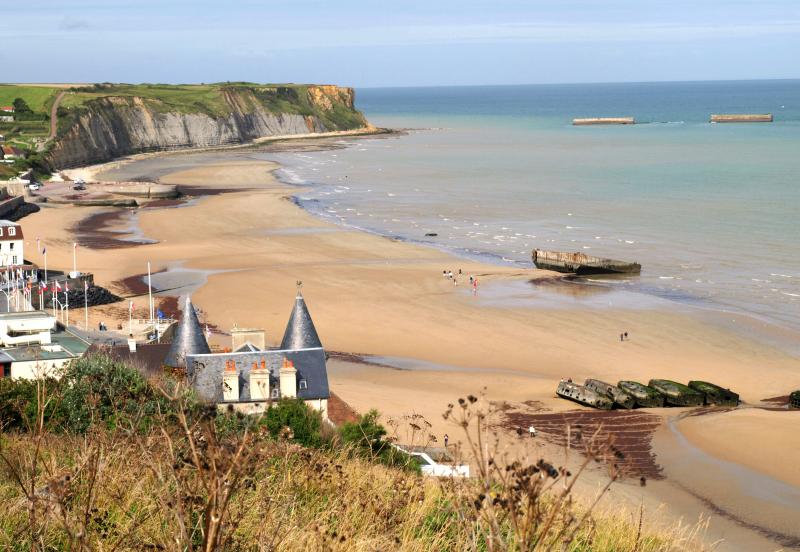
The D-Day Beaches
By Sam Lucas
On 6 June 1944, at approximately 6:30am British time, the largest amphibious invasion in world history began. The culmination of years of intensive planning, training and intricately devised deception campaigns, the operation involved 156,000 soldiers, 195,000 naval personnel, 11,000 airplanes and over 5,000 boats and ships. The invasion was a multi-national effort involving men from across the globe; in addition to the main force of American, British and Canadian troops, servicemen from France, Poland, Australia, Belgium, New Zealand, the Netherlands, Norway, Czechoslovakia (now the Czech Republic and Slovakia), Luxembourg and Greece also took part. After successful airborne operations had taken place early on the morning of the Sixth, the invasion of the Normandy coastline began with landings at five different beaches, codenamed Omaha, Utah, Gold, Sword and Juno.
The formidable defences of Hitler’s Atlantic Wall made the operation incredibly dangerous; troops storming up the long white beaches faced machine gun fire, concrete pillboxes, barbed wire, land mines and other beach obstacles. By the end of the day all five beaches had been successfully cleared, but the costs were phenomenally high; whilst accurate casualty figures for D-Day are almost impossible to ascertain, recent painstaking research estimates that a total of 4,413 Allied soldiers died and around 9,000 were wounded or listed as missing. Figures for the German forces are even harder to determine, but it is estimated that between 4,000 and 9,000 were killed in action. The huge sacrifices made by the brave men who stormed ashore, and the significance of the operation to the final outcome of the war, mean that the D-Day beaches are today the site of various museums, memorials and, most movingly of all, the never-ending rows of pure white gravestones in the numerous cemeteries which are now a part of the region’s landscape.
Sword Beach
Sword is the most easterly of the five beaches and stretches from Ouisterham to Luc-sur-Mer. During the Normandy Landings, soldiers from the British 3rd Infantry Battalion and the Free French Forces were tasked with taking the beach and the surrounding area. By the end of the day they had advanced five miles inland. On the eastern flank of the beach, British Airborne troops had secured the bridges crossing the River Orne and the Caen Canal early on the morning of the 6th June. Out of the 28,845 men who came ashore that day, around 683 lost their lives.
Today a number of museums and monuments are located near Sword Beach, including the Musée de la Batterie de Merville, located in Merville-Franceville-Plage. This museum charts the capture of the coastal battery by the Sixth British Airborne division, using realistic light and sound displays and even features a Dakota aircraft. Further inland from the beach, the Pegasus Memorial is a tribute to the British soldiers who were the first to land on D-Day and liberated the nearby bridge. Informative and knowledgeable guides and a full replica model of a Horsa glider help bring the experience to life.
Juno Beach
The five mile wide beach codenamed Juno runs from Courseulles-sur-Mer to Saint-Aubin-sur-Mer and was heavily fortified by the German forces, making it an extremely difficult and treacherous objective for the Canadian troops tasked with storming it. The first wave of attackers suffered 50% casualties, the second highest casualty rate of any of the attacking forces. Despite facing fierce resistance, by the end of the day 30,000 Canadian troops had managed to push further into France than any other Allied Force.
As a reminder of their immense heroism and sacrifice, many of the small seaside towns are dotted with memorials and plaques dedicated to the different regiments of the Canadian army. The Juno Beach Centre at Courseulles-sur-Mer tells the story of Canada’s military operations and life on its home front during the war and offers a guided walking tour of the beach to help put events into context. The Bény-sur-Mer Canadian War Cemetery contains the graves of 2,044 Canadian soldiers and is a quiet place of reflection and remembrance.
Gold Beach
25,000 British troops landed at Gold Beach, situated to the west of Juno. The attacking force suffered around 400 casualties, mainly due to the heavy German fortifications in a village overlooking the beach. Managing to overcome these difficulties, the British advanced to the outskirts of Bayeux and, with the exception of the Canadians at Juno, came closest of any Allied force to achieving their objectives. The Musée du Débarquement at Arromanches is devoted to the Mulberry Harbour, a portable temporary harbour created by the British to allow for the rapid unloading of cargo onto the beaches during the invasion. The Battle of Normandy Memorial Museum in Bayeux offers a chronological presentation of the events of the Battle of Normandy, as well as displays of weapons, uniforms and other equipment. Also in Bayeux, the largest British cemetery of the Second World War in France contains the graves of 3,843 British soldiers who fought and died in the liberation of the region.
Omaha Beach
Overlooked by 150 foot high bluffs which form naturally strong defensive positions, Omaha Beach was skilfully fortified by the German army with concrete gun emplacements, anti-tank defences and machine gun posts. Allied bombing had left these defences almost completely intact, and the attack quickly became the most intense and deadly of the entire Normandy Landings. American casualties numbered around 5,000 out of the 50,000 that landed, many of those occurring in the first few hours. The true horror and devastation of the attack was famously documented in Steven Spielberg’s Academy Award winning film Saving Private Ryan, which continues to shock audiences to this day.
Today, visitors can wander along the soft golden sand of the beach to truly try and envisage the task that faced the American troops. The memorial at La Pointe du Hoc, a rocky headland overlooking the beach, is a tribute to the incredible bravery of the 255 US Rangers who scaled its steep, 35 metre high cliffs using just ropes and ladders. Overlooking the beach is the tranquil Normandy American Cemetery and Memorial, set in a 172 acre area gifted by the French government in recognition of the ultimate sacrifice made by American troops in the liberation of Europe. The immaculate, emerald green lawns and pure white headstones mark the graves of 9,387 American military dead, whilst the Omaha Beach Memorial commemorates the 1,557 soldiers who were reported missing and as such have no known grave.
Utah Beach
Marking the western flank of the Normandy invasion, Utah Beach was the landing site for 23,250 troops of the US 4th Infantry Division. Thanks to a strong current which pushed the landing craft southeast of their intended destination and effective pre-invasion bombardments and airborne landings, the troops faced relatively light resistance and as such casualties on the beach were the fewest of any of the Allied landings. Nevertheless, 197 men were killed or wounded during the assault, and American Airborne divisions suffered heavy casualties as they fought their way towards the beach.
The story of these fearsome troops is told in fascinating detail at the Airborne Museum in the most famous ‘D-Day village’, Sainte-Mère-Église. The museum displays aircraft, tanks, uniforms and other military equipment to help tell the story of the bold and often tragic job that the young liberators undertook. The town of Sainte-Mère-Église itself was one of the first places to be liberated and is centred around a church featuring a model paratrooper hanging from its spire, replicating the true story of John Steele whose parachute was caught on the church roof during the D-Day invasion. On the beach itself, the Utah Beach Landing Museum in Sainte-Marie-du-Mont invites you to walk along the paths laid by the liberators. Original war memorabilia and a panoramic view over the sand dunes of the flat, wide beach make this an extremely informative and moving experience.
Share this article:



















